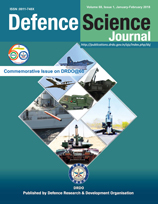Networking of Tracking Radars of Two Different SAM Weapons to Protect the Missile in Intensive Jamming Environment
DOI:
https://doi.org/10.14429/dsj.68.10993Keywords:
Surface-to-air missile, Networking, Tracking radar, Electronic counter measure, Command line of sight guidanceAbstract
Many countries including India use the Russian made SAM-3 (Pechora) surface-to-air missile (SAM) weapon systems to protect their strategic and tactical infrastructure. The mathematical computations done in this paper, conclusively proves that SA-125 low-blow tracking radar of Pechora is vulnerable to jamming. A project was undertaken to overcome the jamming vulnerability of Pechora aiming to design and develop an electronic counter counter measure system. This system networked the Pechora tracking radar with a western tracking radar, Flycatcher, developed by HSA Holland. The latter radar works in a MMW band. When jamming (x band) is employed by enemy aircraft the Low blow radar failed to provide target coordinates. But the flycatcher tracking radar which is tracking in Ka band provided the tracking coordinates (after parallax correction) to the command guidance computer. This way the missile guidance is protected until missile warhead in missile blasts near the target. Extensive trials carried out with a number of aircraft sorties proved the success of this developed system against jamming.
Downloads
Published
How to Cite
Issue
Section
License
 Where otherwise noted, the Articles on this site are licensed under Creative Commons License: CC Attribution-Noncommercial-No Derivative Works 2.5 India
Where otherwise noted, the Articles on this site are licensed under Creative Commons License: CC Attribution-Noncommercial-No Derivative Works 2.5 India


